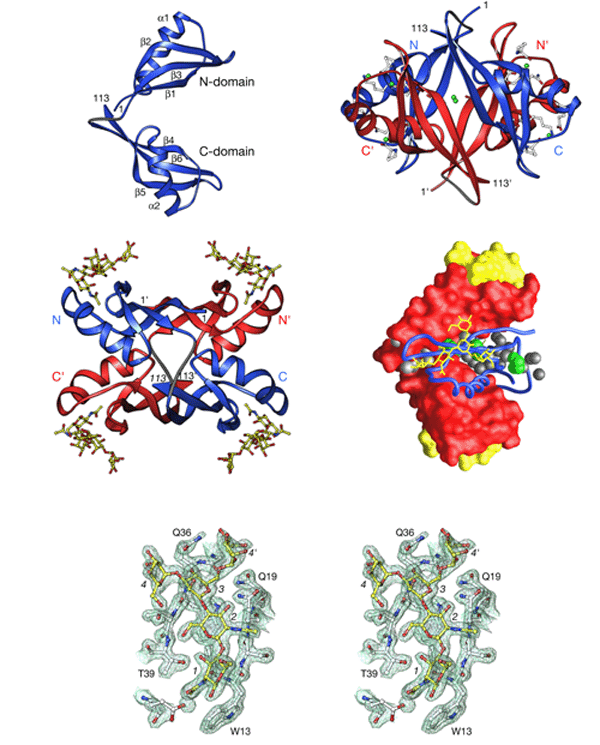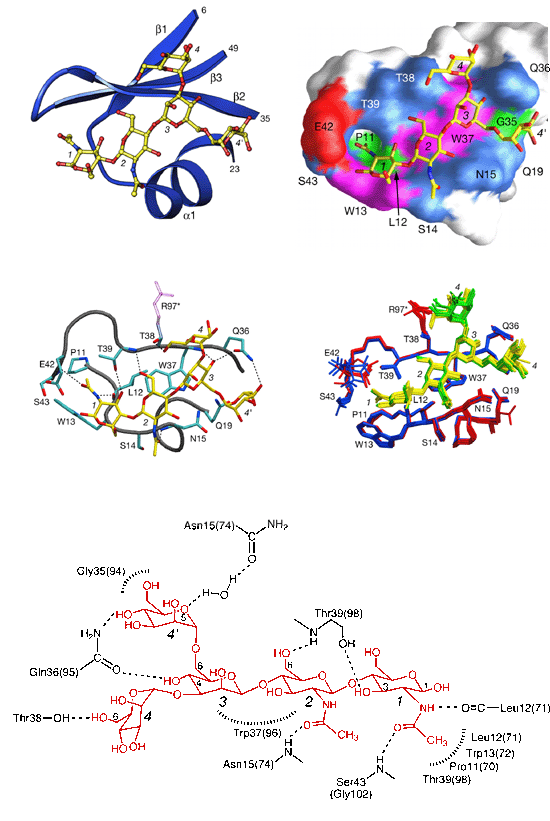
Crystal Structures of the HIV-1 Inhibitory Cyanobacterial Protein MVL Free and Bound to Man3GlcNAc2: Structural Basis for Specificity and High-affinity Binding to the Core Pentasaccharide from N-linked Oligomannoside
The cyanobacterial protein MVL inhibits HIV-1 envelope-mediated cell fusion at nanomolar concentrations by binding to high-mannose N-linked carbohydrate on the surface of the envelope glycoprotein gp120. Although a number of other carbohydrate binding proteins have been shown to inhibit HIV-1 envelope-mediated cell fusion, the specificity of MVL is unique in that its minimal target comprises the Mana(1Æ6)Manb(1Æ4)GlcNAcb(1Æ4)GlcNAc tetrasaccharide core of oligomannosides. We have solved the crystal structures of MVL free and bound to the pentasaccharide Man3GlcNAc2 at 1.9 Å and 1.8 Å resolution, respectively. MVL is a homodimer stabilized by an extensive intermolecular interface between monomers. Each monomer contains two structurally homologous domains with high sequence similarity connected by a short five amino acid residue linker. A water-filled channel is observed between the two monomers. Residual dipolar coupling measurements indicate that the structure of the MVL dimer in solution is identical to that in the crystal. Man3GlcNAc2 binds to a preformed cleft at the distal end of each domain such that a total of four independent carbohydrate molecules associate with each homodimer. The binding cleft provides shape complementarity, including the presence of a deep hydrophobic hole that accommodates the N-acetyl methyl at the reducing end of the carbohydrate, and specificity arises from seven to eight intermolecular hydrogen bonds. The structures of MVL and the MVL:Man3GlcNAc2 complex further our understanding of the molecular basis of high affinity and specificity in protein-carbohydrate recognition.


Williams, D.C., Lee, J. Y., Cai, M., Bewley, C.A. & Clore, G.M. (2005) Crystal structures of the HIV-1 inhibitory cyanobacterial protein MVL free and bound to Man3GlcNac2: structural basis for specificity and high-affinity binding to the core pentasaccharide from N-linked oligomannoside. J. Biol. Chem. 280, 29269-29276. Pubmed PDF
|
Disclaimer: Dr. Clore created this website in his personal capacity. The information on this site and views expressed are his own and do not necessarily represent the views of the National Institutes of Health or the United States Government
|